Tree Mortality Undercuts Ability of Tree-Planting Programs to Provide Benefits: Results of a Three-City Study
Abstract
:1. Introduction
1.1. Benefits of Urban Trees
1.2. Value of Quantifying Benefits
1.3. Costs Associated with Trees
1.4. i-Tree Streets
2. Materials and Methods
2.1. Study Sites
2.2. Planted Tree Re-Inventory
2.3. How i-Tree Works
2.4. Preparation for i-Tree
2.5. Generating Benefit Estimates in i-Tree Streets
2.6. Estimating Costs
2.7. Calculating Cumulative Benefits
2.8. Calculating Annual Survival Rates
2.9. Calculating Growth Rates
2.10. Projecting Future Mortality
2.11. Projecting Future Growth
3. Results
3.1. Re-Inventory Results
3.1.1. Current Benefits
3.1.2. Growth and Survival Rates for Each City
3.2. Projected Populations
3.3. Projected Annual Benefits
3.3.1. Effect of Survival Scenario
3.3.2. Effect of Growth Scenario
3.4. Projected Cumulative Benefits
3.5. Projected Per-Tree Benefits
3.6. Estimated Costs and Net Benefits
4. Discussion
4.1. Future Benefit Increases
4.2. Comparison of Results among Cities
4.3. Effect of Survival vs. Growth Rate
4.4. Maintenance Costs and Net Benefits of Recently Planted Street Trees
4.5. Other Costs of Street Trees
4.6. Comparison to Similar Studies
4.7. Limitations of This Study
Limitations of i-Tree
5. Conclusions
Acknowledgments
Author Contributions
Conflicts of Interest
References
- Xiao, Q.; McPherson, E.G.; Simpson, J.R.; Ustin, S.L. Rainfall interception by Sacramento’s urban forest. J. Arboric. 1998, 24, 235–244. [Google Scholar]
- Nowak, D.J.; Crane, D.E.; Stevens, J.C. Air pollution removal by urban trees and shrubs in the United States. Urban For. Urban Green. 2006, 4, 115–123. [Google Scholar] [CrossRef]
- Donovan, G.H.; Prestemon, J.P. The effect of trees on crime in Portland, Oregon. Environ. Behav. 2012, 44, 3–30. [Google Scholar] [CrossRef]
- Garvin, E.C.; Cannuscio, C.C.; Branas, C.C. Greening vacant lots to reduce violent crime: A randomised controlled trial. Inj. Prev. 2012, 19, 198–203. [Google Scholar] [CrossRef] [PubMed]
- Troy, A.; Grove, M.J.; O’Neil-Dunne, J. The relationship between tree canopy and crime rates across an urban-rural gradient in the greater Baltimore region. Landsc. Urban Plan. 2012, 106, 262–270. [Google Scholar] [CrossRef]
- South, E.C.; Kondo, M.C.; Cheney, R.A.; Branas, C.C. Neighborhood blight, stress, and health: A walking trial of urban greening and ambulatory heart rate. Am. J. Public Health 2015, 105, e1–e5. [Google Scholar] [CrossRef] [PubMed]
- Bell, J.F.; Wilson, J.S.; Liu, G.C. Neighborhood greenness and 2-year changes in body mass index of children and youth. Am. J. Prev. Med. 2008, 35, 547–553. [Google Scholar] [CrossRef] [PubMed]
- Peper, P.J.; McPherson, E.G.; Simpson, J.R.; Vargas, K.E.; Xiao, Q. Lower Midwest Community Tree Guide: Benefits, Costs, and Strategic Planting; US Department of Agriculture Forest Service, Pacific Southwest Research Station: Albany, CA, USA, 2009. [Google Scholar]
- McPherson, E.G.; Simpson, J.R.; Peper, P.J.; Gardner, S.L.; Vargas, K.E.; Xiao, Q. Northeast Community Tree Guide: Benefits, Costs, and Strategic Planting; United States Department of Agriculture Forest Service, Pacific Southwest Research Station: Albany, CA, USA, 2007. [Google Scholar]
- Vogt, J.M.; Hauer, R.J.; Fischer, B.C. The costs of maintaining and not maintaining trees: A review of the urban forestry and arboriculture literature. Arboric. Urban For. 2015, 41, 293–322. [Google Scholar]
- Von Dohren, P.; Haase, D. Ecosystem disservices research: A review of the state of the art with a focus on cities. Ecol. Indic. 2015, 52, 490–497. [Google Scholar] [CrossRef]
- Escobedo, F.J.; Kroeger, T.; Wagner, J.E. Urban forests and pollution mitigation: Analyzing ecosystem services and disservices. Environ. Pollut. 2011, 159, 2078–2087. [Google Scholar] [CrossRef] [PubMed]
- Randrup, T.B.; McPherson, E.G.; Costello, L.R. Tree root intrusion in sewer systems: Review of extent and costs. J. Infrastruct. Syst. 2001, 7, 26–31. [Google Scholar] [CrossRef]
- McPherson, E.G.; Peper, P.J. Infrastructure repair costs associated with street trees in 15 cities. In Trees and Building Sites; Watson, G., Neely, D., Eds.; International Society of Arboriculture: Savoy, IL, USA, 1995; pp. 49–64. [Google Scholar]
- Posner, R.A. Cost-benefit analysis: Definition, justification, and comment on conference papers. J. Leg. Stud. 2000, 29, 1153–1177. [Google Scholar] [CrossRef]
- i-Tree Streets. i-Tree Software Suite v6.0.7. n.d. Available online: http:/www.itreetools.org (accessed on 29 August 2014).
- i-Tree Streets User’s Manual v5.0. n.d. Available online: http://www.itreetools.org/resources/manuals/Streets_Manual_v5.pdf (accessed on 29 August 2014).
- Bloomington Urban Forestry Research Group. About the Bloomington Urban Forestry Research Group (BUFRG) at CIPEC. Available online: https://www.indiana.edu/~cipec/research/bufrg_about.php (accessed on 10 March 2016).
- Bloomington Urban Forestry Research Group. Urban Forestry in 5 U.S. Cities—Ecological & Social Outcomes of Neighborhood & Nonprofit Tree Planting: NUCFAC Grant. Available online: https://www.indiana.edu/~cipec/research/bufrgproj_nucfac.php (accessed on 10 March 2016).
- Vogt, J.M.; Fischer, B.C. A protocol for citizen science monitoring of recently-planted urban trees. Cities Environ. 2014, 7, 4. [Google Scholar]
- Vogt, J.M.; Mincey, S.K.; Fischer, B.C.; Patterson, M. Planted Tree Re-Inventory Protocol; Version 1.1; Bloomington Urban Forestry Research Group at the Center for the Study of Institutions, Population and Environmental Change, Indiana University: Bloomington, IN, USA, 2014. [Google Scholar]
- StataCorp. Stata Statistical Software: Release 13; StataCorp LP: College Station, TX, USA, 2013. [Google Scholar]
- Peper, P.J.; McPherson, E.G.; Mori, S.M. Equations for predicting diameter, height, crown width, and leaf area of San Joaquin Valley street trees. J. Arboric. 2001, 27, 306–317. [Google Scholar]
- Peper, P.J.; McPherson, E.G.; Mori, S.M. Predictive equations for dimensions and leaf area of coastal Southern California street trees. J. Arboric. 2001, 27, 169–180. [Google Scholar]
- Xiao, Q.; McPherson, E.G.; Ustin, S.L.; Grismer, M.E.; Simpson, J.R. Winter rainfall interception by two mature open-grown trees in Davis, California. Hydrol. Process. 2000, 14, 763–784. [Google Scholar] [CrossRef]
- Anderson, L.M.; Cordell, H.K. Influence of trees on residential property values in Athens, Georgia (USA): A survey based on actual sales prices. Landsc. Urban Plan. 1988, 15, 153–164. [Google Scholar] [CrossRef]
- DTE Energy. Your Natural Gas Pricing Options. Available online: https://www2.dteenergy.com/wps/wcm/connect/11919444-45e5-4a7c-afab-33d6db22b198/Gas+Rate+9-14_internet.pdf?MOD=AJPERES (accessed on 31 October 2014).
- Citizens Energy Group. Gas Rate No. D2. Available online: http://www.citizensenergygroup.com/ratesriders/RateNo%20D2%20ResHeatDelivery%20-%20eff.%209-6-11.pdf (accessed on 31 October 2014).
- Pennsylvania Public Utilities Commission. Natural Gas Shopping Tool. Available online: http://www.puc.pa.gov/consumer_info/natural_gas/natural_gas_shopping/gas_shopping_tool.aspx (accessed on 31 October 2014).
- Roman, L.A.; Scatena, F.N. Street tree survival rates: Meta-analysis of previous studies and application to a field survey in Philadelphia, PA, USA. Urban For. Urban Green. 2011, 10, 269–274. [Google Scholar] [CrossRef]
- Brand, D.G. The establishment of boreal and sub-boreal conifer plantations: An integrated analysis of environmental conditions and seedling growth. For. Sci. 1991, 37, 68–100. [Google Scholar]
- Samyn, J.; de Vos, B. The assessment of mulch sheets to inhibit competitive vegetation in tree plantations in urban and natural environment. Urban For. Urban Green. 2002, 1, 25–37. [Google Scholar] [CrossRef]
- Richards, N.A. Modeling survival and consequent replacement needs in a street tree population. J. Arboric. 1979, 5, 251–255. [Google Scholar]
- Miller, R.H.; Miller, R.W. Survival of selected street tree taxa. J. Arboric. 1991, 17, 185–191. [Google Scholar]
- Gilman, E.F.; Black, R.J.; Dehgan, B. Irrigation volume and frequency and tree size affect establishment rate. J. Arboric. 1998, 24, 1–9. [Google Scholar]
- Thompson, J.R.; Nowak, D.J.; Crane, D.E.; Hunkins, J.A. Iowa, US, communities benefit from a tree-planting program: Characteristics of recently planted trees. J. Arboric. 2004, 30, 1–10. [Google Scholar]
- Lu, J.W.T.; Svendsen, E.S.; Campbell, L.K.; Greenfeld, J.; Braden, J.; King, K.L.; Falxa-Raymond, N. Biological, social, and urban design factors affecting young street tree mortality in New York City. Cities Environ. 2010, 3, 1–15. [Google Scholar]
- Boyce, S. It takes a stewardship village: Effect of volunteer tree stewardship on urban street tree mortality rates. Cities Environ. 2010, 3, 1–8. [Google Scholar]
- Gilman, E.F. Effect of nursery production method, irrigation, and inoculation with mycorrhizae-forming fungi on establishment of Quercus virginiana. J. Arboric. 2001, 27, 30–39. [Google Scholar]
- McPherson, E.G.; Simpson, J.R.; Xiao, Q.; Wu, C. Los Angeles 1-Million Tree Canopy Cover Assessment; US Department of Agriculture Forest Service, Pacific Southwest Research Station: Albany, CA, USA, 2008. [Google Scholar]
- McPherson, E.G. Monitoring Million Trees LA: Tree performance during the early years and future benefits. Arboric. Urban For. 2014, 40, 285–300. [Google Scholar]
- Morani, A.; Nowak, D.J.; Hirabayashi, S.; Calfapietra, C. How to select the best tree planting locations to enhance air pollution removal in the MillionTreesNYC initiative. Environ. Pollut. 2011, 159, 1040–1047. [Google Scholar] [CrossRef] [PubMed]
- Strohbach, M.W.; Arnold, E.; Haase, D. The carbon footprint of urban green space—A life cycle approach. Landsc. Urban Plan. 2012, 104, 220–229. [Google Scholar] [CrossRef]
- Sklar, F.; Ames, R.G. Staying alive: Street tree survival in the inner-city. J. Urban Aff. 1985, 7, 55–66. [Google Scholar] [CrossRef]
- Roman, L.A.; Battles, J.J.; McBride, J.R. Determinants of establishment survival for residential trees in Sacramento County, CA. Landsc. Urban Plan. 2014, 129, 22–31. [Google Scholar] [CrossRef]
- Roman, L.A.; Battles, J.J.; McBride, J.R. The balance of planting and mortality in a street tree population. Urban Ecosyst. 2013, 17, 387–404. [Google Scholar] [CrossRef]
- Jack-Scott, E.; Piana, M.; Troxel, B.; Murphy-Dunning, C.; Ashton, M.S. Stewardship success: How community group dynamics affect urban street tree survival and growth. Arboric. Urban For. 2013, 39, 189–196. [Google Scholar]
- Koeser, A.; Hauer, R.; Norris, K.; Krouse, R. Factors influencing long-term street tree survival in Milwaukee, WI, USA. Urban For. Urban Green. 2013, 12, 562–568. [Google Scholar] [CrossRef]
- Wolf, K.L. Business district streetscapes, trees, and consumer response. J. For. 2005, 103, 396–400. [Google Scholar]
- Nowak, D.J.; Crane, D.E.; Stevens, J.C.; Hoehn, R.E.; Walton, J.T.; Bond, J. A ground-based method of assessing urban forest structure and ecosystem services. Arboric. Urban For. 2008, 34, 347–358. [Google Scholar]
- Dobbs, C.; Escobedo, F.J.; Zipperer, W.C. A framework for developing urban forest ecosystem services and goods indicators. Landsc. Urban Plan. 2011, 99, 196–206. [Google Scholar] [CrossRef]
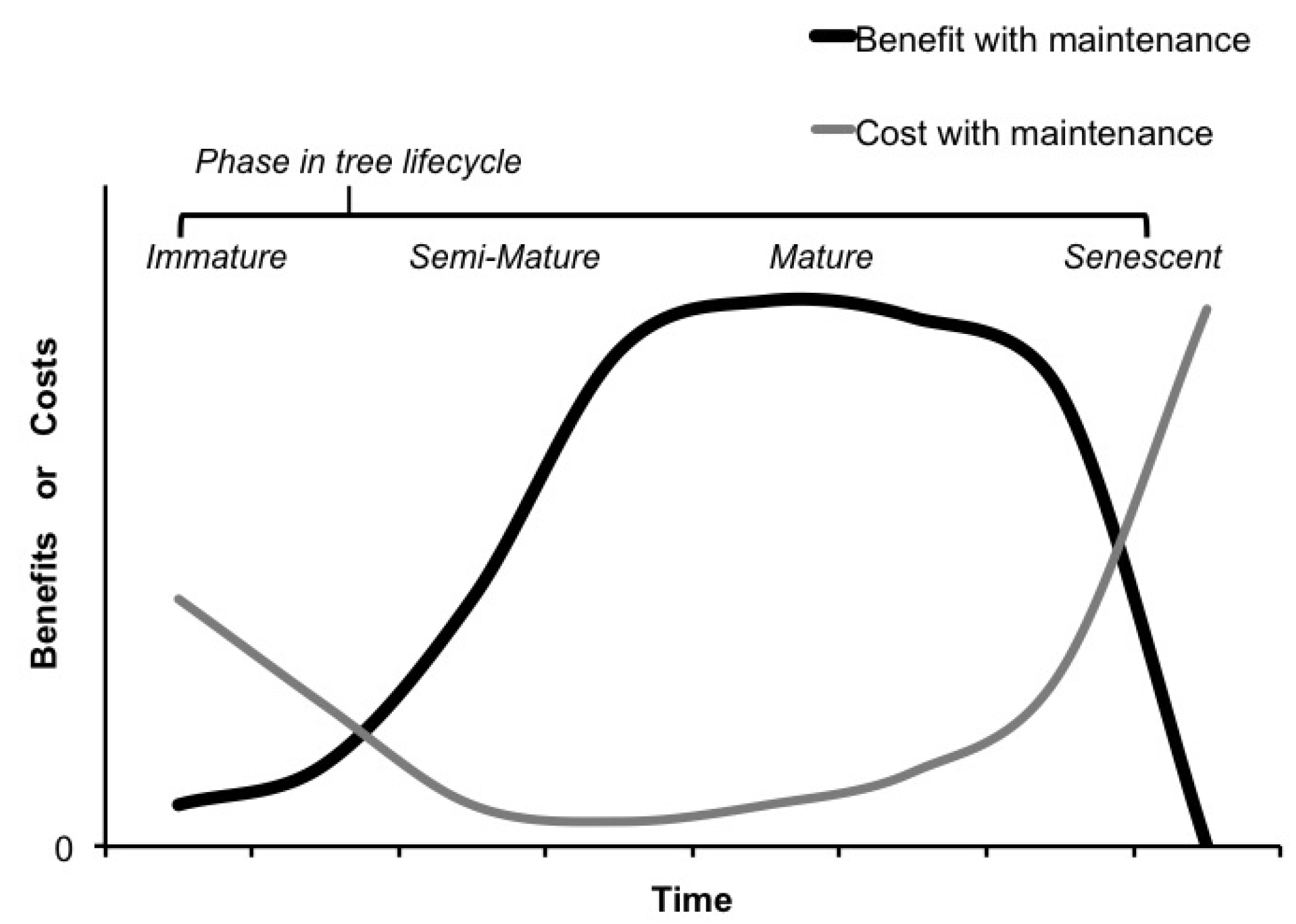


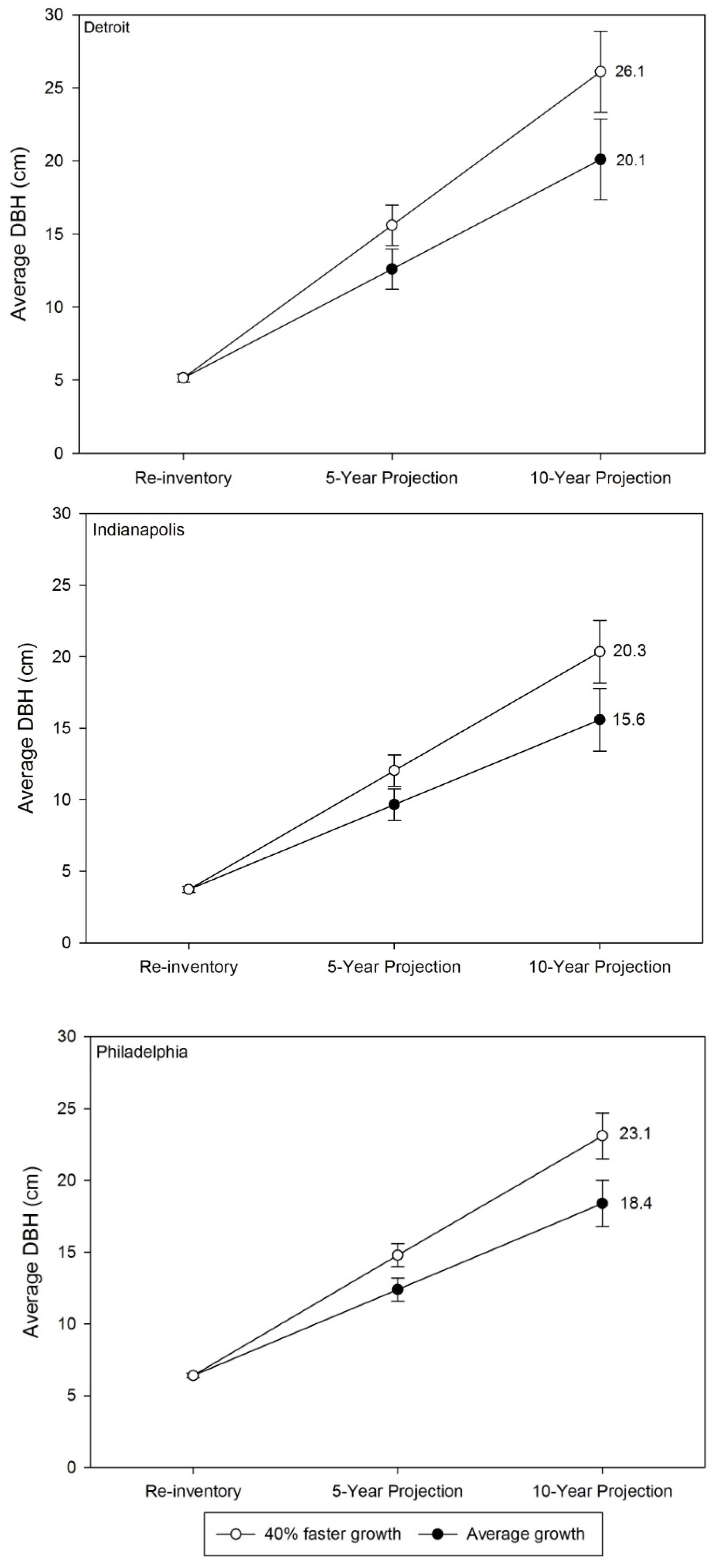
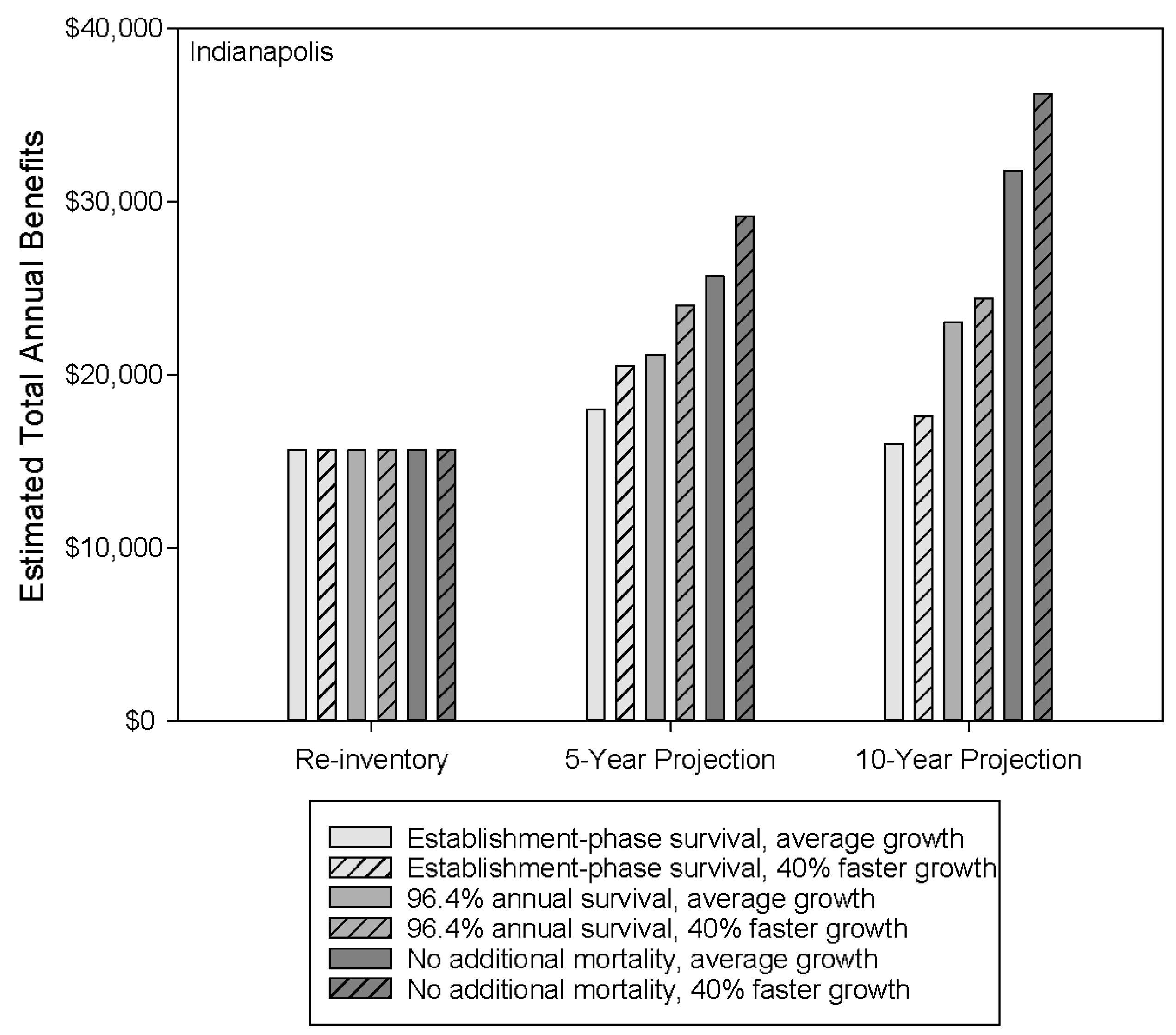
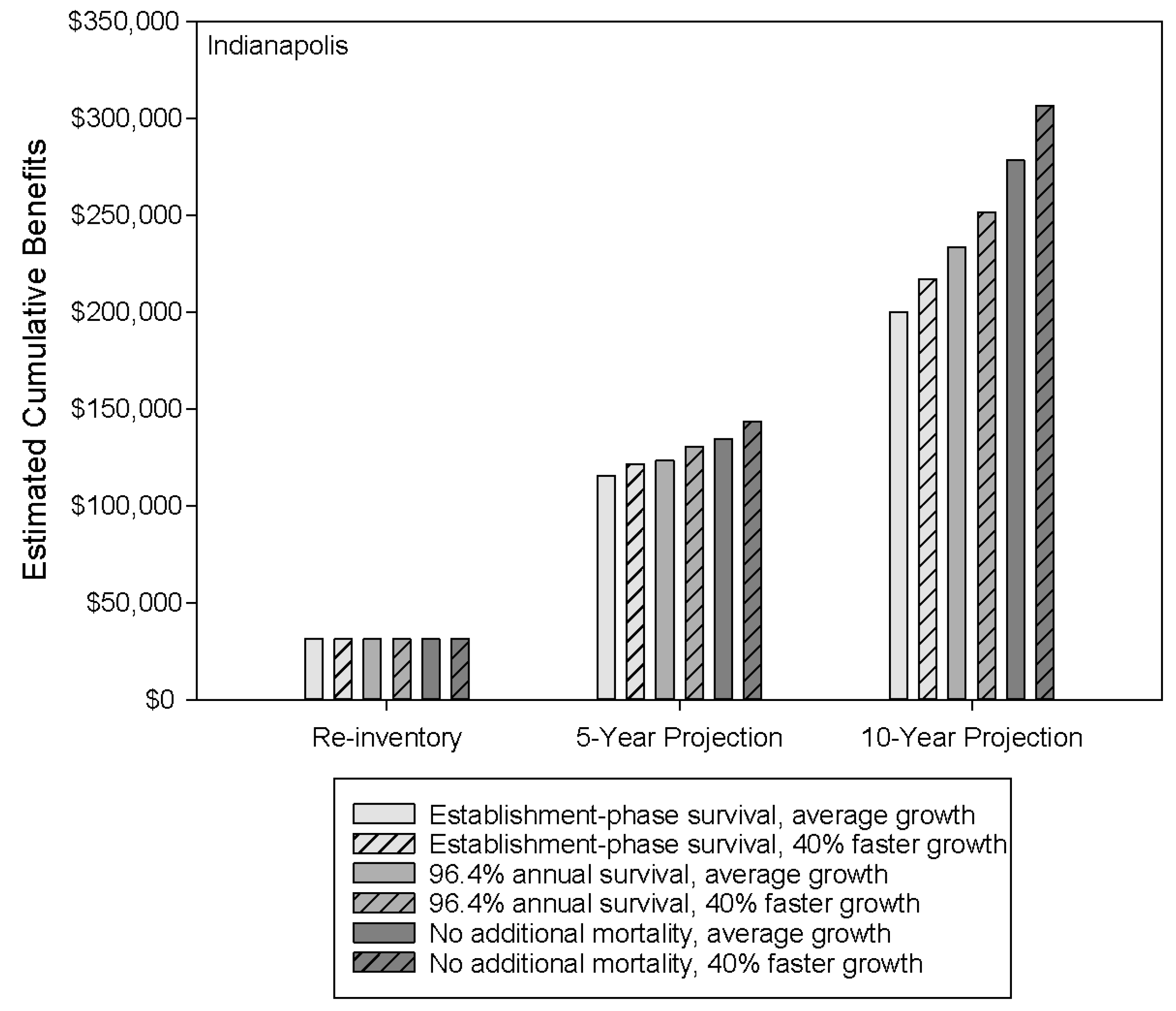
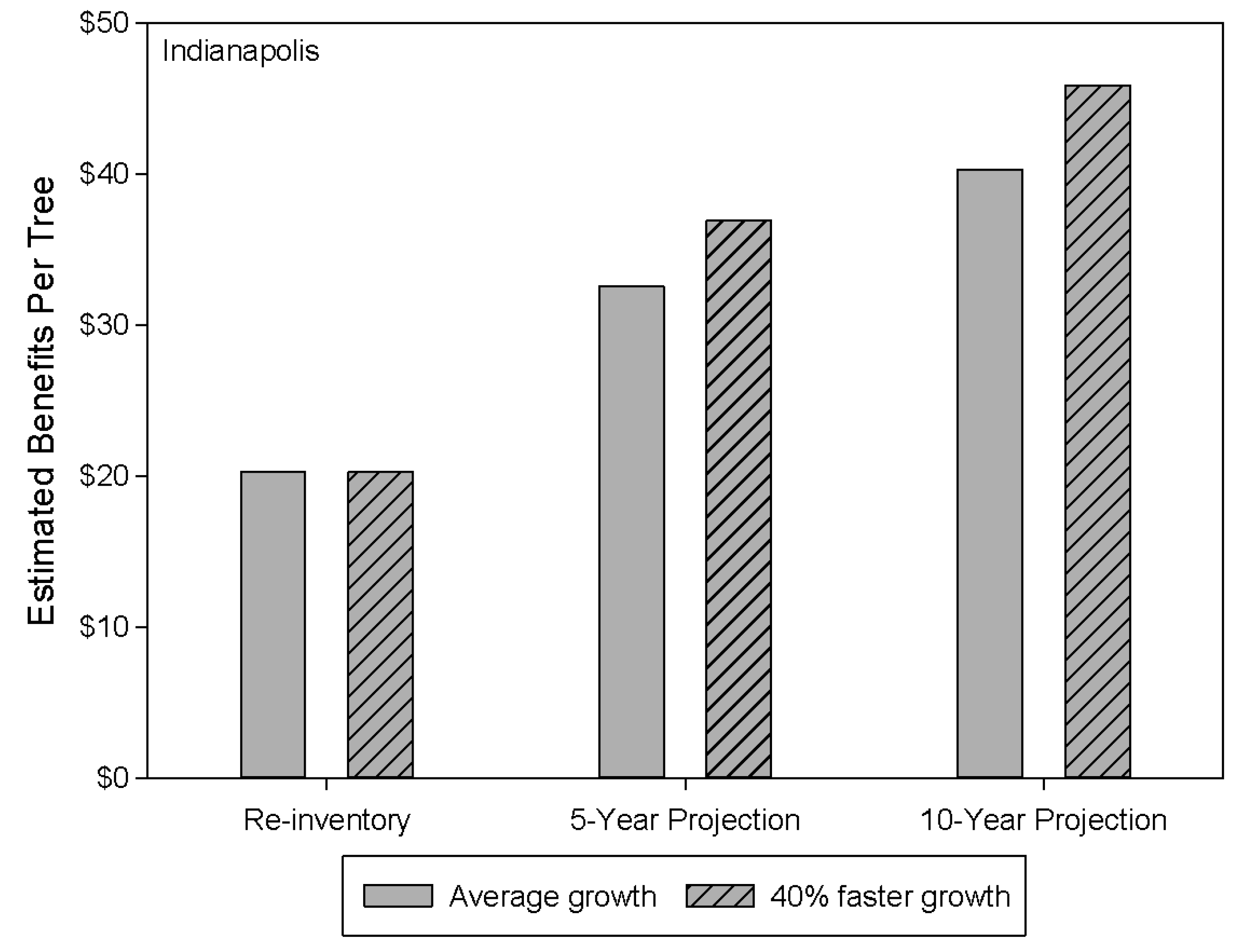

| Rating | Explanation |
|---|---|
| Good | Full canopy, minimal to no mechanical damage to trunk, no branch dieback over 5 cm (2′′) in diameter, no suckering (root or water sprouts), form is characteristic of species. |
| Fair | Thinning canopy, new growth in medium to low amounts, tree may be stunted, significant mechanical damage to trunk (new or old), insect/disease is visibly affecting the tree, form not representative of species, premature fall coloring on foliage, needs training pruning. |
| Poor | Tree is declining, visible dead branches over 5 cm (2′′) in diameter in canopy, significant dieback of other branches in inner and outer canopy, severe mechanical damage to trunk usually including decay from damage, new foliage is small, stunted or minimum amount of new growth, needs priority pruning of dead wood. |
| Dead | Standing dead tree, no signs of life with new foliage, bark may be beginning to peel. |
| Sprouts | Only a stump of a tree is present, with one or more water sprouts of 45 cm (18′′) or greater in height growing from the remaining stump and root system. |
| Stump | Only a stump remains, no water sprouts greater than 45 cm (18′′) high present. |
| Shrub | Existing vegetation is a shrub growth habit rather than tree growth habit, either because a shrub-form was planted or because the species has been pruned into the shape of a shrub (e.g., many crape myrtle, Lagerstroemia sp.). |
| Absent | No tree present, not even a stump remains visible in the location where the tree should have been; this category should also be used for trees that have obviously been replaced (are the incorrect species, much smaller than they should be given the planting date, etc.) and there is no evidence of the original tree. |
| Climate Zone | Study Cities | Reference City | Community Tree Guide Citation |
|---|---|---|---|
| Lower Midwest | Indianapolis, IN | Indianapolis, IN | Peper, et al. 2009 [8] |
| Northeast | Detroit, MI and Philadelphia, PA | Queens, NY | McPherson, et al. 2007 [9] |
| Time Point | Year | Age of Trees (Time in Ground) |
|---|---|---|
| Planting | 2009–2011 | 0 |
| Re-inventory | 2014 | 3–5 years |
| Midpoint * 1 | 2017 | 6–8 years |
| 5-year projection | 2019 | 8–10 years |
| Midpoint * 2 | 2022 | 11–13 years |
| 10-year projection | 2024 | 13–15 years |
| Survival | Growth |
|---|---|
| Establishment-phase | Average |
| Establishment-phase | 40% faster than average |
| 96.4% annual | Average |
| 96.4% annual | 40% faster than average |
| No additional mortality | Average |
| No additional mortality | 40% faster than average |
| City | Total Number of Trees Re-Inventoried | Number of Trees Planted 2009–2011 | Percent of Planted Trees Re-Inventoried |
|---|---|---|---|
| Detroit | 1241 | 6777 | 18% |
| Indianapolis | 1076 | 11,294 | 10% |
| Philadelphia | 1742 | 6894 | 32% |
| City | Total Annual Benefits | Average Annual Benefits Per Tree | Cumulative Benefits |
|---|---|---|---|
| Detroit | $8,548 | $8.91 | $17,096 |
| Indianapolis | $15,635 | $20.25 | $31,268 |
| Philadelphia | $15,556 | $15.70 | $31,112 |
| City | Cumulative Survival Rate | Annual Survival Rate | Relative Growth Rate |
|---|---|---|---|
| Detroit | 79% | 93% | 1.48 cm/year |
| Indianapolis | 80% | 93% | 1.18 cm/year |
| Philadelphia | 59% | 87% | 1.19 cm/year |
| City | Establishment-Phase Survival | 96.4% Annual Survival | No Additional Mortality | |||
|---|---|---|---|---|---|---|
| Average growth | 40% faster growth | Average growth | 40% faster growth | Average growth | 40% faster growth | |
| Detroit | $16,622 | $21,999 | $22,564 | $29,899 | $32,476 | $42,972 |
| Indianapolis | $16,004 | $17,616 | $23,021 | $24,424 | $31,798 | $36,209 |
| Philadelphia | $9,667 | $11,947 | $24,484 | $30,161 | $34,558 | $42,831 |
| City | Establishment-Phase Survival | 96.4% Annual Survival | No Additional Mortality | |||
|---|---|---|---|---|---|---|
| Average growth | 40% faster growth | Average growth | 40% faster growth | Average growth | 40% faster growth | |
| Detroit | $154,000 | $184,000 | $181,000 | $219,000 | $221,000 | $271,000 |
| Indianapolis | $200,000 | $217,000 | $234,000 | $252,000 | $278,000 | $307,000 |
| Philadelphia | $158,000 | $173,000 | $238,000 | $268,000 | $280,000 | $320,000 |
| Average Growth | 40% Faster Growth | ||||
|---|---|---|---|---|---|
| City | Re-Inventory | 5-Year Projection | 10-Year Projection | 5-Year Projection | 10-Year Projection |
| Detroit | $8.91 | $21.88 | $34.96 | $26.97 | $46.26 |
| Indianapolis | $20.25 | $32.56 | $40.30 | $36.94 | $45.89 |
| Philadelphia | $15.70 | $25.01 | $34.87 | $28.76 | $43.22 |
| Indianapolis (Per 1076 Planted Trees) | Establishment-Phase Survival | 96.4% Annual Survival | No Additional Mortality | |||
|---|---|---|---|---|---|---|
| Average Growth | 40% Faster Growth | Average Growth | 40% Faster Growth | Average Growth | 40% Faster Growth | |
| Cumulative benefits for all trees | $200,000 | $217,000 | $234,000 | $252,000 | $278,000 | $307,000 |
| Average cumulative benefits per planted tree | $186 | $202 | $217 | $234 | $258 | $285 |
| Net benefits per planted tree after 10 years | −$114 | −$98 | −$83 | −$66 | −$42 | −$15 |
| Annual Survival Rate | Time Since Planting | Location | Study |
|---|---|---|---|
| 87% | 3–5 years | Philadelphia, PA | This study |
| 93% | 3–5 years | Detroit, MI and Indianapolis, IN | This study |
| 94% | 3–4 years | 20 cities in Iowa | [36] |
| 95.5% | 2–10 years | Philadelphia, PA | [30] (street tree survey) |
| 95.6% | 2 years | New York City, NY | [37] |
| 94.9%–96.5% | Various | Various | [30] (meta-analysis) |
© 2016 by the authors; licensee MDPI, Basel, Switzerland. This article is an open access article distributed under the terms and conditions of the Creative Commons by Attribution (CC-BY) license (http://creativecommons.org/licenses/by/4.0/).
Share and Cite
Widney, S.; Fischer, B.C.; Vogt, J. Tree Mortality Undercuts Ability of Tree-Planting Programs to Provide Benefits: Results of a Three-City Study. Forests 2016, 7, 65. https://doi.org/10.3390/f7030065
Widney S, Fischer BC, Vogt J. Tree Mortality Undercuts Ability of Tree-Planting Programs to Provide Benefits: Results of a Three-City Study. Forests. 2016; 7(3):65. https://doi.org/10.3390/f7030065
Chicago/Turabian StyleWidney, Sarah, Burnell C. Fischer, and Jess Vogt. 2016. "Tree Mortality Undercuts Ability of Tree-Planting Programs to Provide Benefits: Results of a Three-City Study" Forests 7, no. 3: 65. https://doi.org/10.3390/f7030065
APA StyleWidney, S., Fischer, B. C., & Vogt, J. (2016). Tree Mortality Undercuts Ability of Tree-Planting Programs to Provide Benefits: Results of a Three-City Study. Forests, 7(3), 65. https://doi.org/10.3390/f7030065






